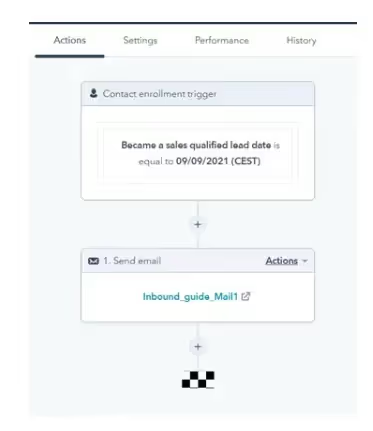Inbound Marketing Workflows: What They Are and How They Work

As your database grows, so does information about your contacts and their behavior. But how do you make the most of this valuable database? The key lies in workflows, better known as workflows of Inbound Marketing.
Thanks to the worflows you can automate processes and you'll connect with your potential customers providing them with the right information at the right time and motivating more people to become customers.
In this article, we thoroughly explore the concept of Inbound Marketing workflows and provide you with practical examples of how you can implement them in your business. Discover how to boost your strategy and get impactful results!
What is a Workflow in Inbound Marketing?
In simple terms, a workflow is a set of automated tasks. In the context of marketing, it involves actions such as sending personalized emails or directing users to a specific page. This process can be triggered automatically, either when you enter new information into your CRM or when a new visitor interacts with your company.
Configuring these triggers or Triggers, we can encourage users to move forward in the buying process, convert more visitors into marketing leads (MQL), or nurture leads so that they become potential sales customers (SQL), highly motivated to make a purchase
Lead Nurturing and Email Marketing Workflows
In the field of Inbound Marketing, workflows and lead nurturing go hand in hand, focused on strengthening relationships with potential customers.
Lead nurturing uses data on contact behavior to personalize marketing actions, designing messages adapted to the reality and specific challenges of the potential customer.
This approach increases the chances that the receiver will perceive the messages as relevant. By creating and publishing personalized content based on the phase of the buyer's journey the potential customer is in, you communicate more directly with your audience.
Get more out of your marketing automation system
Marketing automation often requires specialized software to manage automated workflows.
There are numerous vendors that offer marketing automation solutions with various features, HubSpot being one of the most recognized, we collaborate with him at Novicell, We are a platinum level partner.
Although many leading companies adopt this technology, there is still a perception that implementation can be complicated. That's why 86% of marketers consider ease of use to be crucial when evaluating automation tools. In this context, HubSpot and its workflow features stand out as an excellent starting point.
By employing specific workflows in marketing, you can extract greater business value from the data provided by your automation system. Automating frequent tasks frees up time for other activities, allowing you to focus less on tracking leads and more on “nurturing” them with personalized content, naturally guiding them to the next step in their buying journey.

Triggers or Triggers: the right content in the right place and at the right time
With the right automation tool, you can select different triggers, i.e. criteria for sending specific emails.
This allows you to create different workflows, determining, for example, that a trigger is when a visitor or potential customer:
- It is added to a list in your database.
- Fill out a form on your website.
- He subscribes to your blog.
- Click on a link in your email
- Click on one of your AdWords ads.
Each of these triggers can activate an action that motivates the visitor or potential customer to move forward in the purchase process. It is also possible to combine several triggers. For example, you could establish that a potential customer must have downloaded specific content and read two blog posts on a related topic before the system sends them an email.
This strategy ensures that your potential customers receive emails with personalized content at the right time. Thus, your messages are perceived as relevant and specific, increasing the likelihood of reaching them when they are most committed to your company.
Practical Uses of Workflows in Inbound Marketing
Each user action adds value, and this accumulates as the contact interacts more. High values indicate a strong interest in your company or the information you provide. Highly engaged contacts are more likely to share your content.
So why not explore a workflow that, after a series of actions, sends a friendly email asking to share your content on social networks? Let's look at some practical examples.
Email campaigns increase loyalty
As we mentioned, workflows are a powerful tool for building email campaigns that help to “mature” your potential customers, offering them personalized content in several steps.
For example, you can send friendly messages to new customers and contacts, keeping them engaged after making a purchase, visit your business or attend a seminar.
This approach allows your Potential customers evolve from simple “fans” interested in your channels (potential customers qualified for marketing, MQL) to people motivated to engage in direct dialogue about your products or services and even make a purchase (potential customers qualified for sales, SQL). This process is especially attractive to the sales department.
Nourish existing customers
You can also take advantage of workflows to delight your existing customers with interesting and useful information, encouraging them to take a variety of actions.
You can design email messages that are sent when the system moves a potential customer from one phase of the “life cycle” to another, whether from visitor to prospect, from prospect to customer.
A concrete example (from HubSpot) shows that when a contact meets the criteria to be a qualified sales lead after September 9, 2021, they will receive a specific email. This case exemplifies a simple workflow for potential customers.

Workflows are also valuable when you sell a product or service that involves typical “after-sales support”. Imagine creating a workflow that sends emails with useful information and materials to meet customer needs. This approach not only provides ongoing support, but it also enriches the relationship and improves the overall service experience.
Update contacts
Workflows can also be used to gather information about your contacts.
In this scenario, we assume that your marketing automation software has smart lists, automatically updated when certain criteria are met, triggering actions in the system.
An example would be identify contacts in the same city as your company, ideal for a campaign about your next event.
By taking advantage of these automations, you can achieve several objectives, such as:
- Keep track of prospects and customers with personalized and useful content.
- Convey to potential customers that you understand their concerns, challenges and questions.
- Establish closer relationships with potential customers before starting the sale.
- Save time and resources by eliminate recurring manual processes.
- Managing more leads than sellers could handle individually.
- Purge your database eliminating contacts that no longer interact, optimizing their value.
A surfboard that didn't sell and the workflow that was missing
In the summer of 2016, I was looking for a surfboard. I discovered a reliable online store that offered surfboards and all the necessary equipment for an amateur.
I selected the surfboard and some accessories, added them to the cart, filled out the information forms and added the credit card. When you clicked “Pay”, the store was blocked. An error message appeared, stating that the purchase was not completed. When I returned, the basket was empty and all customer information had been lost. Did I try again? Did you remember what you had selected? No. We waited for an email from the store, which never arrived.
What can we learn here? A store with a well-designed workflow could have saved money on orders and avoided losing customers. Unfortunately, are sacrificing customers and sales because of a buying process that does not prioritize the user. Don't let this happen to your company. Think about every small moment in the buying journey and configure workflows that support the buyer's experience, encouraging them to interact. Put yourself in their shoes and make sure every step is smooth and enjoyable.
Not only do workflows save time on repetitive tasks, but they also personalize your marketing efforts, increasing their effectiveness and sending qualified contacts directly to the sales department.
If you're looking for a marketing automation tool or you need assistance with your inbound marketing strategy, do not hesitate to contact us. Our specialists will be happy to help.
Cómo podemos ayudarte
Consulta los servicios con los que te ayudaremos a conseguir tus objetivos digitales.
